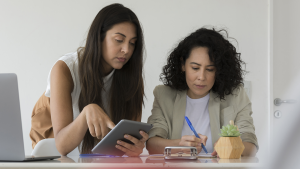More and more organizations are concerned about the increasing environmental impacts that their productions can generate. Society also has the role of finding and encouraging companies that seek national actions to preserve the environment and ISO 14001:2015 Requirement 7.4 Communication can help you.
Companies have sought to implement an Environmental Management System (EMS) in order to meet and comply with environmental requirements and in search of improvements.
The importance of communication arises in the midst of this process, in which it is necessary to verify what the external and internal expectations are in order to be able to meet them through well-targeted processes and actions.
Communication with the entire team is of paramount importance to establish environmental goals and responsibilities and, thus, generate changes.
To provide guidance in this regard, ISO 14001:2015 uses requirement 7.4.1 generalities which is within communication 7.4. It deals exactly with how to establish good communication, which is relevant for the EMS and for the interested parties.
So let’s read it and go through the requirement in full.
What ISO 14001:2015 Requirement 7.4 Communication says
To understand this requirement a little better, let’s stick to an excerpt from the standard:
“7.4 Communication
7.4.1 General
The organization shall establish, implement and maintain the process(es) needed for internal and
external communications relevant to the environmental management system, including:
a) on what it will communicate;
b) when to communicate;
c) with whom to communicate;
d) how to communicate.”
SOURCE: ISO 14001:2015
Here, we can see that requirement 7.4.1 points out that good, effective and relevant communication is concerned with what, with whom, how and when to communicate information. Basically, we have a kind of “5W2H Communication”.
When establishing all communication processes, the organization needs to take into account various aspects such as legal, customer and company requirements. In addition, you need to ensure that communication is clear and targeted to the right stakeholders.
Communication is essential for the organization’s processes
In general, communication in organizations is essential, because through it the plans, objectives, achievements and goals of a job are communicated. Communication with interested parties, in turn, ensures the effective implementation of the Environmental Management System.
Therefore, everyone needs to be able to stay informed about any changes, which projects will be carried out, which actions will be prioritized, etc.
Each organization establishes what is pertinent to its business, but as the standard itself says, it is necessary that the internal or external communication processes, when necessary, are registered and documented.
Proven fact at the end of requirement 7.1.4: “The organization shall retain documented information as evidence of its communications, as appropriate.”
SOURCE: ISO 14001:2015
This helps to better comply with legal requirements and maintain traceability of actions, which is essential.
But after all, what should be communicated?
As the requirement presents us, there are some main points that organizations can guide themselves to know what they should communicate to their business stakeholders.
Overall, the organization needs to communicate relevant information to the EMS across all levels and functions. For this, in its context, the company must determine:
What must be communicated
The relevant information that must be communicated varies for each company and its EMS. In general, it is important that companies seek to communicate the context of their organization, what are their policies and principles, what are their needs and expectations, changes, organizational skills, etc.
But it’s important to reiterate: you need to analyze the information and determine which is relevant to each stakeholder, as well as being transparent in the act of communication. This is the only way to ensure compliance with item 7.4.
When should this be communicated
After defining what will be communicated, it’s time to establish when these actions will be reported. This aspect has many variations and should be analyzed according to the need to inform interested parties about respective changes in the company and the EMS.
Certain processes need to be communicated quickly, when something may present delays or risks, for example. Others may be communicated for longer periods of time when their processes allow. There are even periodic communications, here the context and reality of each company applies.
To whom to communicate
In this process, it is important to establish those responsible or sectors that will make these communications, as well as those who will receive the communications.
These will determine which groups and how often and need for processes or changes to be informed. This, again, varies from context to context, helping to ensure that communication is effective and timely.
How to communicate
Finally, it is necessary to establish how all information will be communicated. As with all the previous items, everything varies according to the organization’s processes.
Depending on the type of information that needs to be passed on, the need and urgency, it is necessary to find the most effective means for this. Because the information can be passed on by email, phone call or even a quick message on the cell phone, for example.
Today, thanks to technological advances, there are at least dozens of ways to communicate. Then we can transit through those that best suit the reality of the company. Now, some information may need to be communicated through a good old-fashioned meeting, going over in person.
Good communication is the key to the success of your business
The objective of the ISO 14001:2015 Requirement 7.4 is for organizations to be effective in communicating important actions to stakeholders relevant to the EMS.
When communication is done correctly, processes can flow better and many problems can be solved or even avoided. For this, it is not necessary to communicate everything all the time, so the requirement helps companies to communicate efficiently, properly and filtered.
In short, communication is necessary! And for communication to be done correctly, it is necessary to know how and in what way to pass on all the information. Following the “5W2H” of item 7.4.1 can help a lot in planning actions.











